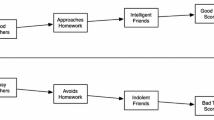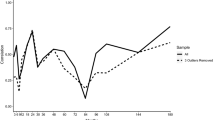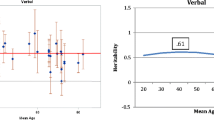Abstract
We examine updated Wechsler IQ data in 7-year old twins from the Louisville Twin Study for evidence of an interaction between the heritability of IQ and socioeconomic status. Data records that had never been entered were recovered, allowing us to increase previously reported sample sizes by more than 20 %. Twin families were assigned socioeconomic status scores using a Hollingshead index based on parental education and occupation. A structural equation model in which genetic and environmental variances were modeled as squared linear functions of SES provided ambiguous replication of earlier findings from the National Collaborative Perinatal Project: relations between SES and heritability for performance and full scale IQ were in the same direction as the previous report, but at p < 0.07. As was the case in Turkheimer et al. (Psychol Sci 14(6):623–628, 2003), no interaction was found for VIQ. These results cannot yet be taken as a definitive replication of Turkheimer et al. (Psychol Sci 14(6):623–628, 2003). Many more measurement occasions, subtests and environmental moderators remain to be analyzed.



Similar content being viewed by others
References
Asbury K, Wachs TD, Plomin R (2005) Environmental moderators of genetic influence on verbal and nonverbal abilities in early childhood. Intelligence 33(6):643–661
Bates TC, Lewis GJ, Weiss A (2013) Childhood socioeconomic status amplifies genetic effects on adult intelligence. Psychol Sci 24:2111–2116
Beam CR, Turkheimer E (2013) Phenotype–environment correlations in longitudinal twin models. Dev Psychopathol 25(01):7–16
Dolan CV, de Kort JM, van Beijsterveldt TC, Bartels M, Boomsma DI (2014) GE Covariance through phenotype to environment transmission: an assessment in longitudinal twin data and application to childhood anxiety. Behav Genet 44(3):240–253
Fischbein S (1980) IQ and social class. Intelligence 4:51–63
Grant MD, Kremen WS, Jacobson KC, Franz C, Xian H, Eisen SA, Toomey R, Murray RE, Lyons MJ (2010) Does parental education have a moderating effect on the genetic and environmental influences of general cognitive ability in early adulthood? Behav Genet 40(4):438–446
Hanscombe KB, Trzaskowski M, Haworth CM, Davis OS, Dale PS, Plomin R (2012) Socioeconomic status (SES) and children’s intelligence (IQ): in a UK-representative sample SES moderates the environmental, not genetic, effect on IQ. PLoS One 7(2):e30320
Kirkpatrick RM, McGue M, Iacono WG (2015) Replication of a gene–environment interaction via multimodel inference: additive-genetic variance in Adolescents’ General Cognitive Ability Increases with Family-of-Origin Socioeconomic Status. Behav Genet 45(2):200–214
Muthén LK, Muthén BO (1998–2015) Mplus user’s guide, 6th Ed. Muthén & Muthén, Los Angeles
Purcell S (2002) Variance components models for gene–environment interaction in twin analysis. Twin Res 5(06):554–571
Rowe DC, Jacobson KC, van den Oord EJCG (1999) Genetic and environmental influences on vocabulary IQ: parental education level as a moderator. Child Dev 70:1151–1162. doi:10.1111/1467-8624.00084
Scarr-Salapatek S (1971) Race, social class, and IQ. Science 174:1285–1295. doi:10.1126/science.174.4016.1285
Tucker-Drob E, Bates T (2014) The world’s literature on gene x social class interactions on cognitive ability: a meta-analysis. In: Presentation at 2014 meeting of the behavior genetics association, Charlottesville
Tucker-Drob EM, Rhemtulla M, Harden KP, Turkheimer E, Fask D (2011) Emergence of a gene × socioeconomic status interaction on infant mental ability between 10 months and 2 years. Psychol Sci 22:125–133. doi:10.1177/0956797610392926
Turkheimer E, Horn EE (2014) Interactions between socioeconomic status and components of variation in cognitive ability. In: Behavior genetics of cognition across the lifespan. Springer, New York, pp 41–68
Turkheimer E, Haley A, Waldron M, D’Onofrio B, Gottesman II (2003) Socioeconomic status modifies heritability of IQ in young children. Psychol Sci 14(6):623–628
Turkheimer E, Beam CE, Finkel D, Dickens WT, Sederberg R, Davis DW (2015) The Scarr-Rowe Interaction in the Louisville Twin Study. In: Paper presented at the meeting of the Behavior Genetics Association, San Diego
van der Sluis S, Willemsen G, de Geus EJ, Boomsma DI, Posthuma D (2008) Gene–environment interaction in adults’ IQ scores: measures of past and present environment. Behav Genet 38(4):348–360
Wilson RS (1983) The Louisville twin study: developmental synchronies in behavior. Child Dev 54:298–316
Acknowledgments
This work was supported by grants 1R03AG048850-01, T32AG020500, T32AG000037-37, F31AG044047-01A1 from the National Institute of Aging.
Author information
Authors and Affiliations
Corresponding author
Ethics declarations
Conflict of Interest
Eric Turkheimer, Christopher E. Beam and Deborah W. Davis declare that they have no conflict of interest.
Human and Animal Rights and Informed Consent
The secondary data analysis reported here was approved by the Institutional Review Board for the Social and Behavioral Sciences at the University of Virginia. All procedures followed in the secondary data analysis reported here were in accordance with the ethical standards of the responsible committee on human experimentation (institutional and national) and with the Helsinki Declaration of 1975, as revised in 2000 (5). Informed consent was obtained from all patients for being included in the study.
Rights and permissions
About this article
Cite this article
Turkheimer, E., Beam, C.E. & Davis, D.W. The Scarr-Rowe Interaction in Complete Seven-Year WISC Data from the Louisville Twin Study: Preliminary Report. Behav Genet 45, 635–639 (2015). https://doi.org/10.1007/s10519-015-9760-4
Received:
Accepted:
Published:
Issue Date:
DOI: https://doi.org/10.1007/s10519-015-9760-4




